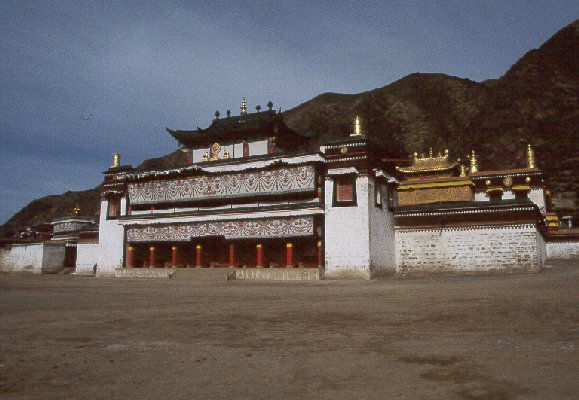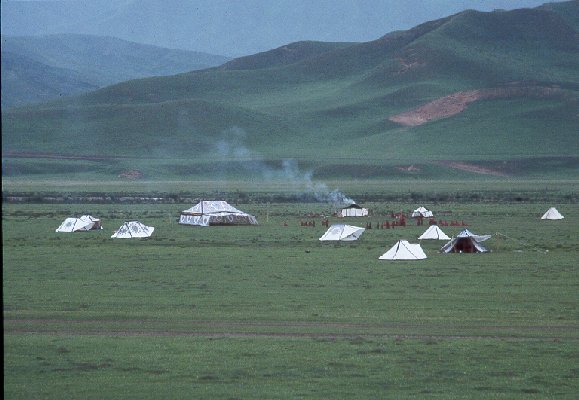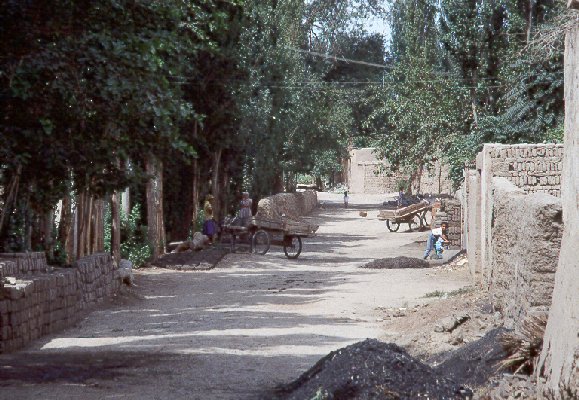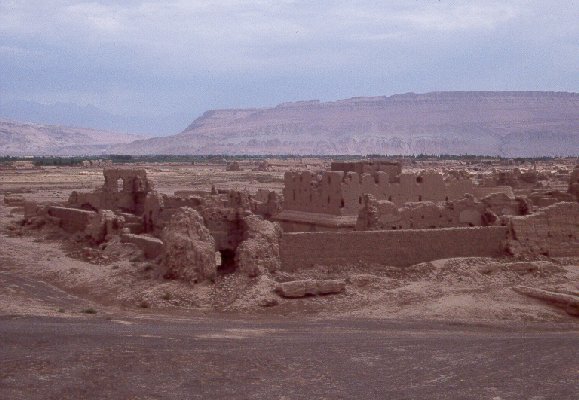
| Home Page of Paul Dalhoeven |

| Home Page of Paul Dalhoeven |
 Iíve only been once to China, for three months, as part of a journey of half a year, from Indonesia, Singapore, Malaysia, Thailand, Hong Kong, and China to Pakistan.
Iíve only been once to China, for three months, as part of a journey of half a year, from Indonesia, Singapore, Malaysia, Thailand, Hong Kong, and China to Pakistan.
 In the center of China, near the city of Lanzhou, I went to a city named Xiahe (pronounce: Tsjiage), and was amazed to see that this city was so Tibetan, whilst Tibet itself is at least 1000 km further south. The city was divided in two part, as was quite a common practice from the Chinese. To outnumber the locals, they make a second city with the same name, which is inhabited by Han-Chinese only. Not all of them moved voluntarily to the remote areas. For the smallest crime, Chinese are requested to move to another city in the hinterland.
In the center of China, near the city of Lanzhou, I went to a city named Xiahe (pronounce: Tsjiage), and was amazed to see that this city was so Tibetan, whilst Tibet itself is at least 1000 km further south. The city was divided in two part, as was quite a common practice from the Chinese. To outnumber the locals, they make a second city with the same name, which is inhabited by Han-Chinese only. Not all of them moved voluntarily to the remote areas. For the smallest crime, Chinese are requested to move to another city in the hinterland.
 The city used to have twelve big Tibetan monasteries, but after the cultural revolution only one remained. At least this one is fully operational now, with impressive Tibetan rituals. Devotees walk numerous times around the monastery, and after every step they lay down on the ground in worship. They wear leather gloves and protection for their knees, as this is quite a difficult job. Getting up and down every few seconds looks like a heavy task for their backs.
The city used to have twelve big Tibetan monasteries, but after the cultural revolution only one remained. At least this one is fully operational now, with impressive Tibetan rituals. Devotees walk numerous times around the monastery, and after every step they lay down on the ground in worship. They wear leather gloves and protection for their knees, as this is quite a difficult job. Getting up and down every few seconds looks like a heavy task for their backs.
During a walk in the surrounding mountains, I met two Tibetan monks, and I started a small conversation with my hands and feet, as I still donít master any level of Chinese. One of these monks had a cool pair of sunglases, made locally from natural glass. Outrageously beautiful, but pretty expensive at 20 dollars, which was way more than my daily budget on this low budget journey. Even today I regret that I dinít buy one.
In a youth hostel (thatís the one name this hotel deserved), I heared from some other tourists that they wanted to visit the plains. That was a great idea, as we were at high altitude, between sloping green mountains. Maybe we would even spot a yak. Well, we did see a few yaks, a kind of exaggerating bull with a terrible stench. We drove further over these enormous plains of grass, where nothing could be seen but grass, as agreed beforehand.
 Then we saw some white spots in the distance, which to our surprise turned out to be hundreds of beautifully painted tents in the middle of nowhere, all filled with Tibetan monks in full dress. They were busy chanting and reciting, as you can hear on one of these links below. I can say that I was deeply impressed by this spectacle. Many monks came all the way from Tibet, and this was just pure luck to see this happening. I wasnít allowed to take pictures, so I put my tele lens on.
Then we saw some white spots in the distance, which to our surprise turned out to be hundreds of beautifully painted tents in the middle of nowhere, all filled with Tibetan monks in full dress. They were busy chanting and reciting, as you can hear on one of these links below. I can say that I was deeply impressed by this spectacle. Many monks came all the way from Tibet, and this was just pure luck to see this happening. I wasnít allowed to take pictures, so I put my tele lens on.
In a clearing some monks made a big stake out of conifer, and I think they must have carried that all the way us, as there was no sign of any conifer or even a single tree. They piled up faggots till some two meters, and covered it with sweets, presents and grain flour. On top they placed a statue of Buddha, made from yak butter. Then they ignited the stake, whilst blowing on a king size cone shell. Two monks threw very thin papers imprinted with stamped drawing into the uprising smoke, and these papers flew up high in the sky. Eventually, they came down again, and then itís the trick to catch one before it touches ground. The gods accepted these leaflets in pleasure, blessed them and sent them back to earth. Actually, it could have been gravity as well, but anyway, I caught one and there could be a connection to the fact that a few years later I was blessed with a sweat wife and two little boys.
 Slightly dazed after such an experience, I wandered around in the surrounding fields. Then I noticed a group of monks sitting in a circle. Again I put the telelens on my camera, but they indicated that I should approach them. They offered me a place in their circle of elderly monks, all dressed in red. They all had a smile from ear to ear, and looked pretty happy, far away from any worry in the world. We spoke a bit, with hands and feet, and I tried to explain where Iím from. (helŠn, hťlan, HÍlan, hŤlaan, Ö ) but I think something went wrong in the translation. I showed them my Lonely Planet book, and they were mighty impressed by the picture of the Dalai Lama. Did I had more pictures of him? No, but the next time Iíll go there, Iíll carry loads of those pictures, as they are not for sale in China.
Slightly dazed after such an experience, I wandered around in the surrounding fields. Then I noticed a group of monks sitting in a circle. Again I put the telelens on my camera, but they indicated that I should approach them. They offered me a place in their circle of elderly monks, all dressed in red. They all had a smile from ear to ear, and looked pretty happy, far away from any worry in the world. We spoke a bit, with hands and feet, and I tried to explain where Iím from. (helŠn, hťlan, HÍlan, hŤlaan, Ö ) but I think something went wrong in the translation. I showed them my Lonely Planet book, and they were mighty impressed by the picture of the Dalai Lama. Did I had more pictures of him? No, but the next time Iíll go there, Iíll carry loads of those pictures, as they are not for sale in China.
 It took a day and a half by train to arrive in Turfan, an oasis city in the middle of the Taklamakan desert, which means something like ďyou can get in, but you wonít get outĒ. Turfan is also known as the furnace of China, as it is located in a depression, about 50 meters below sealevel. All desert heat stays hanging in the oasis, and a temperature of 45 degrees centirgrade is guaranteed, even in the shade. Itís a beautiful oasis, very a very Islamic atmosphere. Barbed men, women with headscarfs, mosques with arabesques and mighty old minarets. And the market is is cosy, colorful and just great. As is usual in an oasis, all centimeters are used. Tiles were removed from the streets, to plant grapevines. Donít even think about taking one single grape, as these guys really need the harvest to survive, with matching penalties.
It took a day and a half by train to arrive in Turfan, an oasis city in the middle of the Taklamakan desert, which means something like ďyou can get in, but you wonít get outĒ. Turfan is also known as the furnace of China, as it is located in a depression, about 50 meters below sealevel. All desert heat stays hanging in the oasis, and a temperature of 45 degrees centirgrade is guaranteed, even in the shade. Itís a beautiful oasis, very a very Islamic atmosphere. Barbed men, women with headscarfs, mosques with arabesques and mighty old minarets. And the market is is cosy, colorful and just great. As is usual in an oasis, all centimeters are used. Tiles were removed from the streets, to plant grapevines. Donít even think about taking one single grape, as these guys really need the harvest to survive, with matching penalties.
At noon I went to the post office, which turned out to be closed. It ainít half hot, mum. I went back to the hotel, and halfway back I noticed some kind of garage, but with lots of chairs outside. It turned out to be a bar. The old fashioned gasoline pump at the street didnít serve gasoline, but beer ! What a great idea. They served the beer in big plastic mugs and it looked so darn inviting that I couldnít resist. It was served between 8 and 12 degrees centirgrade, whilst the city was about 50 in the shade. Many times, beer in china tastes like pancakes should taste, but this was wonderful. So I had another, and enjoyed my holidays to max extent. When I tried to leave, I noticed that the glasses must have been half a liter, and my legs felt like twice the usual weight. Where sweat stopped during the drinking, now it was streaming over my back. I clumsily made my way back to the hotel, and regretted I didnít had airco. I must have picked up some malaria somewhere, and fell in bed. Later that night it got better, but I regretted the situation, boozing at home with friends might give the same sensation, but at least you had a great evening with friends. Heat and dehydration make beer a dangerous liquid.
 The next day I went to the ďflaming mountainsĒ, deep red rock formations, nearby an old deserted oasis, now dry and in ruins. The desert slowly but steadily moves to the west, absorbing cities. Where a new oasis starts, thatís where the new city is build: Turfan. The ruins were in great shape, and it must have been an impressive city, long time ago.
The next day I went to the ďflaming mountainsĒ, deep red rock formations, nearby an old deserted oasis, now dry and in ruins. The desert slowly but steadily moves to the west, absorbing cities. Where a new oasis starts, thatís where the new city is build: Turfan. The ruins were in great shape, and it must have been an impressive city, long time ago.
Some kilometers further, between the flaming mountains, there was an ancient monastery complex. This is a unique spot, where Chinese culture blended with Indian and greek culture. The latter was introduced by the Nestorians, some two thousand years ago. Itís very strange to see Indian gods, portraited in ĺ face. Unfortunately, most of the frescos were missing. In 1900, some german archeologist removed the frescos with a chainsaw, in an unprofessional way. He shipped them all to Berlin, were they were displayed in the national museum. This museum was destroyed, together with this beautiful collection, by bombardments in 1944. Today you can only admire the holes in the monastery, where once some most spectacular frescos used to be.
After Turfan I continued to Urumqi, by train through the Taklamakan desert.